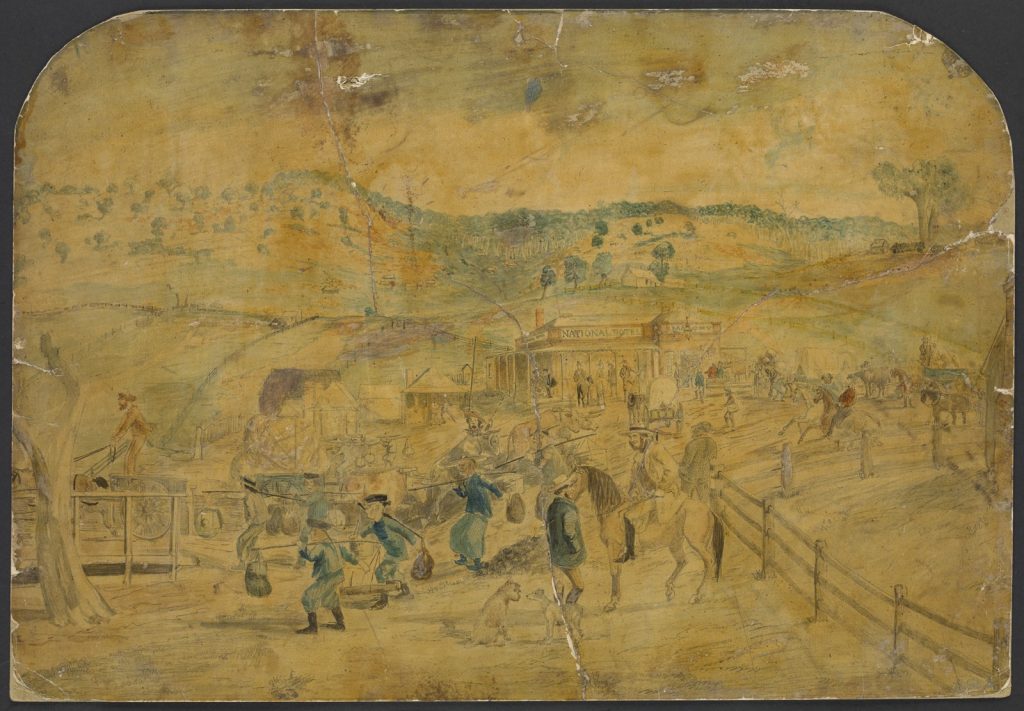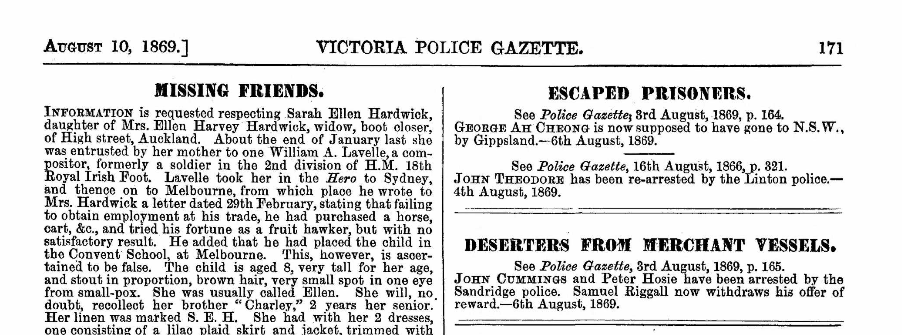In the mid 19th century, a wave of Chinese migrants came to Australia in search of prosperity. By 1861, over 24,000 Chinese individuals were living in Victoria 1. Many resided in gold mining towns such as Sandhurst, Castlemaine, Maryborough, Avoca, Omeo, Daylesford, Ballarat, Smythesdale, and Beechworth. While many Chinese migrants eventually returned home, some chose to make a permanent home in Victoria.

The State Library has various records to help you research your Victorian Chinese ancestors. The majority of these resources can be viewed in the Newspaper and Family History Reading Room. A good place to start would be to work out how and when they migrated to Victoria.
Passenger lists
The Public Record Office Victoria holds early Victorian passenger lists. You can search the Index to unassisted passenger arrivals 1852-1923 on their website. The index provides the name and age of the person, the ship, month of arrival, and port details. The full passenger list can provide further information, such as your ancestor’s language skills, occupation and nationality. Many of these passenger lists are available to view on the Ancestry website, which you can access for free until the end of December with your State Library membership. Alternatively, you can view the microfiche version in our Newspaper and Family History Reading Room.
Note: The spelling of names varied and could be open to the interpretation of the scribe at the time. It’s therefore useful to keep an open mind when searching for your ancestor’s name.
Here is a section from the Eliza Jane passenger list, displaying the names of passengers who travelled from Hong Kong in 1855.

Some of the Chinese migrants arrived in South Australia or New South Wales before making their way to Victoria, so you might want to consult interstate archives.
Newspapers
Historical newspapers can be a great source of information for family historians. The State Library holds a vast collection of historical newspapers that you can use for your research. Listed below are just some of the early regional newspapers you could explore. Some of these papers are digitised on the Trove website. Others can be viewed in microfilm or in hard copy at the State Library.
Ararat
The Mount Ararat advertised and chronicle for the district of Wimmera.
Ballarat
Ballarat times and Bunninyong and Creswick’s. creek advertiser
The Ballarat Times
The Ballarat and Southern Cross
The Ballarat Star
The Miner and Weekly Star
The Chinese advertiser (Ballarat)
The English and Chinese Advertiser
Bendigo
The Bendigo Advertiser
Beechworth
The Ovens and Murray Advertiser
The constitution and Ovens mining intelligencer.
Castlemaine
The Castlemaine advertiser and county of Talbot chronicle.
The miner’s right and Castlemaine Advertiser
Directories
Post office and trade directories can be another useful way to trace your ancestor. You can find a comprehensive list of the directories we hold on the Researching your Victorian ancestors research guide.
If your ancestor lived in Melbourne, you could try searching the Sands & McDougall Melbourne Directory. Every 5 years of this directory has been digitised on the State Library’s website. The University of Melbourne has also digitised every year of the Sands & McDougall Melbourne directories from 1857 to 1880.
Here is an entry for Clin Geon Chong. He was a general dealer listed in Chinatown.
Burial records
Burial records can be another great resource. We hold the following publications in our Newspapers and Family History Reading Room.
- Fading links to China: Ballarat’s Chinese gravestones and associated records, 1854-1955
- Chinese memorials & memories: the White Hills Cemetery
- Chinese cemeteries in Australia
- Chinese graves in the Beechworth Cemetery, Beechworth, Victoria
- Chinese in the Creswick Cemetery: headstones and transcriptions, a cultural interpretation
- Old Chinese section : Campbell’s Creek Cemetery, Castlemaine Victoria
- Chinese graves in cemeteries in Victoria: Echuca Cemetery, Avoca Cemetery, Rutherglen Cemetery, Yackandandah Cemetery, Eddington Cemetery, Ararat Cemetery, Vaughan Cemetery, Pennyweight Flat Cemetery
Victoria Police Gazettes
Some families have a skeleton in the closet. You never know, you may have a relative who had a run-in with the law. To check if that is the case, it is worth searching the Victoria police gazette to see if there were any notices circulated about your ancestor. Victims of crime are also mentioned, so it can be worth searching even if your ancestor was a law abiding citizen.
The State Library holds issues of the Victoria police gazette from 1853-1971. Many of the Victoria police gazettes are available to view on the Ancestry website.
Here is a paragraph in the Police gazette about George Ah Cheong, an escaped prisoner who dashed off to NSW via Gippsland.

Resources for researching Chinese family history in China
The following resources may be useful for researching your ancestors who lived in China.
- The Chinese Biographical Archive provides biographical information on almost 70,000 people (in English, German and Chinese). Start by searching the 3 volume index.
- China Collection of genealogies, 1239-2014 on FamilySearch
- The Chinese recorder index: a guide to Christian missions in Asia, 1867-1941 (The Chinese recorder is held in the Monash University Library)
- Research guide to Chinese genealogy / by May Yan
- Basic guide to Chinese genealogy / by Danny Boey
- You are royalty : a guide to your Chinese ancestor / A. R. Chinn
We hope these resources help you get started with your research. For further assistance, feel free to contact our Ask-a-librarian service.
More to explore
Chinese Australian Cultural Society (Ballarat)
Golden Dragon Museum (Bendigo)
Museum of Chinese Australian History (Melbourne)
Gum San Chinese Cultural Centre (Ararat)
Chinese Market Garden of Melbourne (CAFHOV)
Early Chinese Restaurants of Melbourne 1857-1970s (CAFHOV)
State Library’s guide to Gold miners and mining
CAFHOV – Chinese Australian Family Historians of Victoria. CAFHOV provide a forum for Chinese Australian family historians, researchers of Chinese Australia and post-graduate students and academics undertaking research into aspects of Chinese Australian history and culture.
CAFHOV has the Victorian CEDT index, an online searchable index to three registers of applications for Certificates Exempting from Dictation Test (CEDT) from 1904-1959. Further information on the importance of the Victorian CEDT Registers can be found on the Historian Sophie Couchman’s website.
CAFHOV recently launched the Chinese Community in Maryborough, Victoria: Water Rates 1887 – 1936. A list of people who have paid water rates in the early days.
Here is a downloadable Guide to Chinese-Australian Family Research in PDF format published by the Chinese Museum.
Chinese graves at Melbourne General Cemetery
https://cafhov.github.io/chinesegraves/
Chinese Australian Oral Histories (based on data collected by Dr Couchman).
https://www.cafhov.com/chinese-australian-oral-histories/
References
- Victoria. Parliament. (1863). Census of Victoria, 1861. Population tables. Melbourne: J. Ferres, Govt. Printer.



Many Chinese worked on Vineyards in the Rutherglen/ Gooramadda/ Brown’s Plains area in Nth East Victoria. When my great great grandfather James Martin died (in 1890,) his probate papers had a list of all Chinese workers he had employed and the amount of money owing to them. The head man was Ah Why who was responsible for them receiving the money. One relative mentioned that on Fridays, the Chinese would walk to Cornishtown to do their shopping and return at dusk, carrying their goods on sticks over their shoulders with little lamps attached. He said that the twinkling of the little lights looked like “fairy-land”. He was only a young boy at the time (pre. 1906).
Ah Why always collected donations for charities in Beechworth and his name often appeared in the “Ovens & Murray Advertiser”.
Fay J
Yes. An employer’s dossier may contain a list of employees. What a find. Thank you for sharing your story.
What a lovely story Fay. Many thanks for sharing.